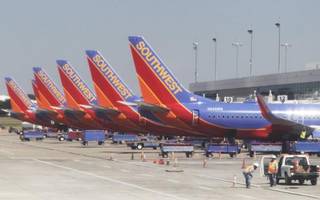Five years ago, Louis Smith’s organization would put on job fairs for airline pilots and have plenty of pilots but few airlines. Now his job fairs attract plenty of airlines but need more pilots.
It’s an indication of how the airline industry has turned around over the past five years. It also underlines the growing difficulty in getting enough pilots to staff the nation’s airline cockpits.
That’s true “especially in the regional sector,” Smith said Wednesday. “That’s what changed dramatically.”
His group, FAPA.aero (Future and Active Pilots Advisors), is holding a job fair Friday at the Dallas/Fort Worth Airport Marriott in Irving. So far, about 600 pilots have signed up to visit with prospective employers.
Among the companies recruiting pilots are American Airlines Inc. and two of its regional subsidiaries, Envoy Air Inc. and Piedmont Airlines; Allegiant Air, a Las Vegas-based carrier; and Republic Airways, parent of Republic Airlines, Chautauqua Airlines and Shuttle America.
There also will be several companies that contract to provide crews to non-U.S. carriers, as well as other aviation companies.
The 600 pilots seem like a lot, Smith said, until one realizes that major airlines are adding hundreds of pilots this year — many of them drawn from regional carriers, which then need to replace the ones moving up.
Today’s situation is a dramatic turnaround from early in the past decade when many carriers quit hiring, laid off thousands of pilots and slashed pilot salaries and benefits.
In addition, a change in the mandatory pilot age affected hirings. In December 2007, the Federal Aviation Administration moved the retirement age for airline pilots from 60 to 65. That kept thousands of pilots on the job longer.
Smith’s stats show that of 15 major passenger and cargo airlines, only one hired pilots in 2009. That was JetBlue with 30 pilots.
American hired no new pilots between 2002 and 2012. Delta Air Lines Inc. and Northwest Airlines Inc., which merged in 2008, and United Airlines Inc. all hired no pilots from 2002 to 2006.
In addition, dozens of airlines went out of business during the last decade. FAPA counts 52 airlines that quit flying since 2004, taking nearly 7,700 jobs with them.
By comparison, FAPA counts more than 1,800 pilot hires from seven major airlines so far in 2013, with more hires planned for next year.
Smith, FAPA’s president, said that with the change in the industry, the pilots at the job fairs tend to be employed and are looking for a better job with more pay and better benefits. It’s not the hardships that many applicants faced in the depth of the industry’s downturn.
“It’s better dealing with people who are not laid off and just wanting to moving up in the world as opposed to people who in many cases were laid off and desperate and in financial crisis,” Smith said.
The problem remains at the regional-airline level, where starting pay for first officers tends to be not much over $20,000 and experienced pilots are jumping to join the better-paying major carriers.
“The regional airline sector is having difficulty finding qualified and willing pilots, and the best and quickest solution will be job guarantees at the mainline carriers,” Smith said.
For decades, Smith said, the airline industry didn’t have to look very hard for a supply of pilots. The reason: The U.S. military spun off a large number of pilots who left the armed forces and joined airlines.
But that traditional pipeline has largely run dry.
“For various reasons, military pilots are no longer the primary source of new pilots for the airlines, and converting to a talent pool primarily from civilian sources will require significant changes,” he said.
A factor making it harder to attract qualified pilots now is a change in FAA rules to be an airline pilot. Before the 2013 change, first officers needed a commercial pilot certificate, which required 250 hours of flying. Now they need an airline transport pilot certificate and 1,500 hours as a pilot.
Along with the job fair, FAPA is also offering a free conference for high school students who may be thinking about a pilot career.
For some time, Smith said, it was the airline pilots who were discouraging their sons and daughters from getting into the same profession.
“If you started a conversation five years ago with active and retired pilots from most major airlines, you would likely get a giant ‘thumbs down’ on the profession. The pay cuts and pension terminations took their toll,” he said.
Now, though, pilots are once again encouraging their kids to consider the profession “as the pilot hiring has increased and significant pay increases have been negotiated at the mainline carriers,” Smith said.
Follow Terry Maxon on Twitter at @tmaxon.















To post a comment, log into your chosen social network and then add your comment below. Your comments are subject to our Terms of Service and the privacy policy and terms of service of your social network. If you do not want to comment with a social network, please consider writing a letter to the editor.